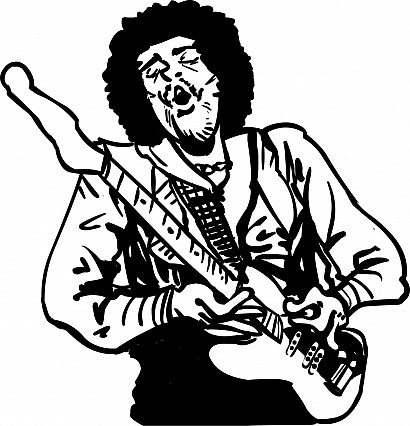Hendrix Wakes Up Woodstock With "Star-Spangled Banner"
Jimi Hendrix closes out Woodstock with an early morning performance of "Hey Joe." The festival headliner, he was supposed to play the previous night, but when it ran long, he ended up taking the stage on a Monday morning. His set includes a scorching rendition of "The Star Spangled Banner."
While shutting down Woodstock, Hendrix becomes a human tuning fork for the '60s zeitgeist, dousing the US national anthem in tie-dyed mix of rage and exuberance. Some say the guitarist is possessed by the spirit of God as he plays. Others say it's the Devil. Nobody questions that he's possessed by something. On the fourth and last day of Woodstock, the festival grounds look more like a refugee camp than a musical festival. Considering the revolutionary stance held by most on the scene, "refugee camp" is probably an apt comparison that the participants themselves would embrace. The festival's peak attendance of around 400,000 has dwindled to less than 200,000. Those who remain are exhausted and filthy. Hendrix takes the stage wearing a white, fringed coat reminiscent of Native American garb, coupled with blue jeans. He is calling his backing band Gypsy Sun & Rainbows, rather than the formerly held Jimi Hendrix Experience. In this new lineup, Billy Cox replaces Noel Redding on bass and Larry Lee is added as a second guitarist. The group has only had time to do two rehearsals. None of that seems to matter, however, as Hendrix teases a few notes from "Voodoo Child (Slight Return)" before ripping into a furious, psychedelic interpretation of "The Star Spangled Banner." Hendrix is like a fire lizard, many times seeming on the verge of spinning out of control into madness or ecstasy before masterfully grabbing hold and bringing it back under wraps. The performance acts as a Rorschach text for all who see it. Many, such as Heart's Ann Wilson, hear explosions and gunshots in the song and view it as a statement against the Vietnam War. Others hear a threat to all that traditional America holds dear. As for the artist himself, he tells Dick Cavett that the performance wasn't blasphemous or combative. To him, it was simply "beautiful." Hendrix's "Star Spangled Banner" sears itself into the psyche of the '60s generation. Somehow, in its distorted way, the performance gives sound to all the semi-rational hopes and fears of the era. For many, it is the defining moment of a defining cultural event.

No comments:
Post a Comment